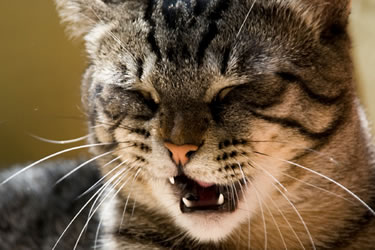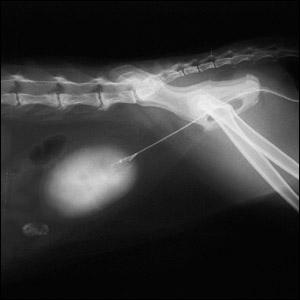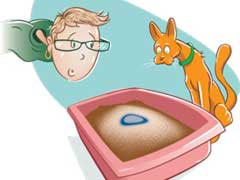
 Bald spots are a common occurrence in cats, they can affect many parts of the body and for any number of reasons.
Bald spots are a common occurrence in cats, they can affect many parts of the body and for any number of reasons.
Hair loss may be in one localised spot, such as an abscess, multiple lesions (ringworm), or larger patches of hair loss with conditions such as psychogenic alopecia, hyperthyroidism and Cushing's syndrome. Bald spots may be well defined, or areas of patchy/thinning hair.
Flea allergy dermatitis - This is an extremely common condition in which your cat becomes hypersensitive to the saliva of the flea. A localised reaction occurs, including lumps and bumps (particularly around the neck and on the back, close to the tail), and thinning to bald patches of fur.
Abscess - Usually caused by a bite wound which becomes infected. The body walls off the area, which forms a localised area of pus. A warm lump will be felt just under the skin, hair loss may occur over the affected area, if the abscess ruptures, a foul smelling discharge will ooze out. Treatment involves draining and cleaning the abscess, along with a course of antibiotics.
Ringworm - A highly contagious fungal infection characterised by the presence of circular lesions on the skin. Treatment involves medicated shampoos/dips and medication to inhibit the growth of the fungus.
Psychogenic alopecia - This is a behavioural disorder in which your cat over-grooms as a way to relieve stress. Your cat licks and bites the fur beyond what is considered "normal" grooming, which can result in areas of bald or thinning hair. Finding and addressing the cause, along with keeping your cat's routine the same, and providing him with plenty of attention. Anti-anxiety or antidepressents may be recommended in severe cases.
Food allergy - Hair thinning or loss due to food allergies are typically seen around the face, and neck. Non seasonal itching and inflammation can occur. Treatment involves switching your cat over to a "low allergenic" diet. In some cases, your cat may develop allergies to the new food.
Miliary dermatitis - This condition is characterised by the presence of red, crusty lesions and hair loss. It is a disease complex with many causes including allergies, infection, parasites, drug hypersensitivity and hormonal disorders. Finding and eliminating the cause where possible, along with corticosteroids to relieve inflammation and antibiotics if infection is present.
Feline acne - Some cats can develop blackheads on the chin, which become inflamed and infected (folliculitis). The hair becomes thin/sparce and the area can look quite reddened and sore. There are a number of causes of feline acne, including poor grooming habits, using plastic food bowls, hormones. Keeping the area clean and switching to glass or ceramic bowls is the usual treatment. Glucocorticoids may be neccessary to reduce inflammation.
Folliculitis - This condition occurs when the hair follicle becomes inflamed and infected. It is characterised by papules and hair loss. Feline acne often results in folliculitis as the blocked pores become inflamed and infected.
Squamous cell carcinoma - This is a type of skin cancer which is often caused by excessive exposure to the sun. Tumours can occur on any part of the body, but the head is the most common area. White cats or cats with white patches are particularly vulnerable to developing SCC. Symptoms include balding of the affected area and lesions which do not heal.
Topical medications - Certain topical medications such as those used to treat fleas can cause hair loss in cats. If this occurs, it is advised you use another form of medication in the future. If the area of hair loss becomes inflamed or your cat experiences other symptoms, please seek veterinary care.
Vaccine reaction - From time to time, some cats can develop a bald spot where they have had a vaccination. The hair grows back over time. Keep an eye on the area and check for a lump under the skin. If it grows in size, or is still there after 4-8 weeks, seek veterinary attention.
Hyperthyroidism - This is caused by a benign tumour of the thyroid gland. Typical symptoms include weight loss, a rough appearance to the fur, increased appetite, fast heart rate and bald patches/hair loss. This condition can be treated either with radioactive iodine, which destroys the tumour or surgery.
Cushing's syndrome - Caused by an excess of cortisol, either due to medication or a tumour of the adrenal or pituitary glands.
Eosinophillic granuloma complex - This is a group of skin lesions affecting different parts of the body. Due to the infiltration of cells known as eosinophils, which are white blood cells which usually attack parasites. The condition is believed to be caused by allergic reactions (for example flea bites), food hypersensitivity or inhalant allergies. Different parts of the body can be affected. Rodent ulcers are one form which is characterised by a lesion found usually on the upper lip (although the lower lip can also be affected), the area becomes red, swollen and hair loss occurs. Other forms can result in bald lesions on the body and legs. Finding and eliminating the allergen if possible, along with steroids to reduce inflammation, and in severe cases, immunosuppressive drugs. Surgical excision may be necessary if lesions do not heal.
 Pregnant Cats With Fleas and Worms – How To Treat Safely?
When y
Pregnant Cats With Fleas and Worms – How To Treat Safely?
When y
 Cat Ear Mites – How To Get Rid of Them?
What i
Cat Ear Mites – How To Get Rid of Them?
What i
 Sneezing and Nasal Discharge in Cats
Sneezing and Nasal Discharge in Cats
Sneezing and Nasal Discharge in Cats
Sneezing and Nasal Discharge in Cats
 Dysuria (Trouble Urinating) in Cats
Dysuria (Trouble Urinating) in Cats
Dysuria (Trouble Urinating) in Cats
Dysuria (Trouble Urinating) in Cats
 Top 5 Cat Urinary Tract Infection Home Remedies
Cat ur
Top 5 Cat Urinary Tract Infection Home Remedies
Cat ur
Copyright © 2005-2016 Pet Information All Rights Reserved
Contact us: www162date@outlook.com